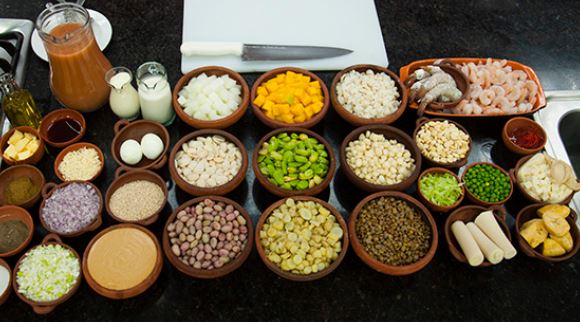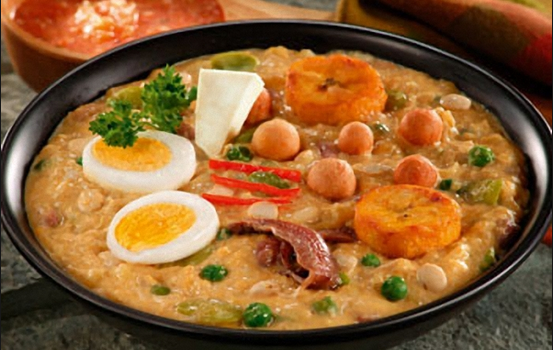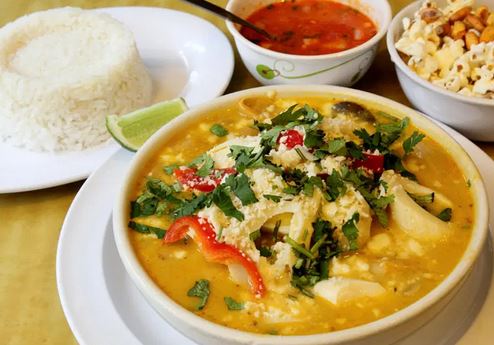Cuenca’s Fanesca: Steeped in family tradition, you can only get the famous soup during Easter season

Editor’s note: Cuenca’s Easter soup, fanesca, is considered by many to be the best in Latin America and it is a tradition among Cuencanos to have at least one bowl of it during Holy Week. It is considered so good, in fact, that it was the subject of a cover story in New Yorker magazine in 2005. Although it has traditionally been served only during Holy Week, many restaurants and mercado food courts vendors begin serving it weeks early. This article is reposted from the Miami Herald and New World Review.
By David Morrill
It’s a busy time of year for Juan Diaz at Cuenca’s 10 de Agosto Mercado on Calle Larga. Although he usually helps his wife, Rosa, manage the family vegetable stall, in the weeks before Easter he is busy assembling the ingredients for fanesca, the traditional Ecuadorian soup served during Holy Week.”
 “I have more than 30 customers and they depend on me to find everything they need,” says Diaz, who visits other vendors in the market, collecting the needed items. “It takes hours to find all of the ingredients so I do it for them and save them the time.”
“I have more than 30 customers and they depend on me to find everything they need,” says Diaz, who visits other vendors in the market, collecting the needed items. “It takes hours to find all of the ingredients so I do it for them and save them the time.”
Among the ingredients Diaz collects and puts in paper sacks, each bearing the hand-written name of a customer, are bacalao seco, or salted cod, used for the soup base, beans, peas and a variety of grains, including lupine, fava, lima beans, quinoa, lintels and corn. He also collects, to individual order, a variety of other ingredients including squash, pumpkins, potatoes, plantains and eggs. Most of customers, he says, buy their own herbs and spices.
Diaz emphasizes that a true fanesca must contain 12 grains, representing the 12 apostles of Christ. “We can never forget the meaning of the soup and that is about the Holy Week and Easter,” he says.
The salted fish is the central ingredient in any fanesca, Diaz says, calling it the carne de Cristo.
As important as finding all the right ingredients, it is the preparation of fanesca that determines its true measure. Although it can be made in as little as 24 hours, connoisseurs say the best takes days. The cod must be soaked several times in milk or water over a two or three day period. The grains are often soaked and pre-cooked and some require husking. The process is a labor of love passed down through generations, and each family has its own tradition of preparation.
In Cuenca, as in most of Ecuador, fanesca is served as a family meal during Holy Week. It is the main course and is often accompanied by humitas, mashed potatoes, salad and dessert. The annual fanesca feast easily rivals the Christmas Eve dinner as the most important meal of the year for Cuenca families.
Who makes the best fanesca?
Although arguments have raged for years about which part of Ecuador has the best fanesca, Cuencana Rosa Vintimilla, author of Fanesca de Fanescas, says the idea of a competition is pointless. “There is no such thing as an authentic fanesca,” says Vintimilla. “There are many recipes and most of them, if they are prepared properly, are very good. Ingredients and tastes vary from one part of the country to the other so all fanescas have unique qualities.”
 She also points out that opinions about fanesca are generally a family matter. “Each family has its own fanesca and the tradition has been passed down from mother to daughter for many years,” says Vintimilla. “If you ask me who made the best fanesca, I will always tell you that it was my grandmother.”
She also points out that opinions about fanesca are generally a family matter. “Each family has its own fanesca and the tradition has been passed down from mother to daughter for many years,” says Vintimilla. “If you ask me who made the best fanesca, I will always tell you that it was my grandmother.”
Cuenca’s fanesca attracted international attention in 2005 when it was featured in a New Yorker article by Calvin Trillin, associate editor for the magazine and columnist for the New York Times and the Nation. Trillin, who has visited Cuenca on several occasions, wrote a memoir about his quest for Cuenca’s best fanesca during a visit where he brushed up on his Spanish. The literary equivalent of the late television food celebrity Anthony Bourdain and the author of many books and articles on food around the world, Trillin adopted a keen interest not only in eating the famous soup but understanding its origins.
He wrote: “My first trip to one of Cuenca’s markets made it obvious that I was about as close to the source of fanesca’s ingredients as I could get without living in the middle of a bean patch. All the vegetables and spices required — corn, for instance, and fava beans and a couple of kinds of squash—grow in the area, and some of them apparently don’t make it as far as Guayaquil, which is only thirty minutes away by air. That may be because the distribution system seems to consist largely of indigenous women who come to the market from the countryside, many of them in the bright-colored flared skirts and high-crowned Panama hats that can make even a small woman of some years look rather, well, zippy.”
Where to find fanesca
For those who are not Cuenca natives, restaurants are the logical fanesca option during Holy Week. Although some serve fanesca the entire week, most offer it only after Wednesday. Where to go? Rosa Vintimilla recommends El Jardin at Hotel Victoria on Calle Larga in El Centro and Rancho Chilena on Av. España.
For a more colorful and authentic option, consider eating your soup in the food court of one of the city´s eight mercados. Several vendors at the 10 de Agosto market, where Juan Diaz gathers ingredients for Cuenca families, are known for serving up a top-notch brew.
Ultimately, Diaz agrees with Vintimilla that the quality of the soup is in the mouth of the beholder. “I do my job to find the things that go into the soup. Then, it is up to the cooks to make it good.”

















